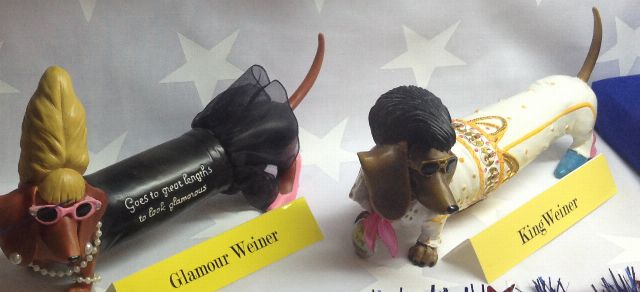
Skills we can develop
Examine your assumptions
In everyday communication we automatically examine our assumptions about the prior knowledge and beliefs of our audience. As an example, think about trying to teach one of your binding structures to a non-book artist. The adhesives, tools and processes; none of them could be assumed to be familiar to your audience. They may not even understand why you would bother to spend your time in such a way. Now imagine teaching me the same process. Your adjustment to these two audiences would probably be automatic and unconscious.
Artwork springs from a different fount than technical knowledge. And our motives driving the effort are different. We may completely focus on capturing the idea-from-within and strive to translate it into an equivalent visual form. In this situation, we become our own audience.
There's nothing wrong with this approach, but if we also hope to have others view our work and share an experience similar to ours, we will need to deliberately do what we do automatically in other situations. We'll need to consider who our audience is and how likely they are to respond to the clues in our work. We will need to examine our assumptions.
The use of a particular word, phrase or sentence may have meaning to you that depends on memories unique to you. Symbols and images you use may depend on your unique experiences for their meaning and emotional resonance. To communicate similar feelings to your audience, you may need to find language and symbols that are more widely shared.

View language as a material
We're all in the habit of making careful selection of materials that are best for our book's mood and meaning. We should learn to apply the same selection process to the language we use in our projects. Language is really nothing more than a raw material for our creation. And it has the dual benefit of being completely free and of taking no space at all to store!
Writing art content requires not just effective sentences, but effective words and phrases. The sound or rhythm of the syllables may come under scrutiny.
Take a look at this pulled quote for one authors rumination on the thoughtful use of language. Or, consider this poem by Elinor Morton Wylie
Pretty Words
Poets make pets of pretty, docile words:
I love smooth words, like gold-enamelled fish
Which circle slowly with a silken swish,
And tender ones, like downy-feathred birds:
Words shy and dappled, deep-eyed deer in herds,
Come to my hand, and playful if I wish,
Or purring softly at a silver dish,
Blue Persian kittens fed on cream and curds.I love bright words, words up and singing early;
Words that are luminous in the dark, and sing;
Warm lazy words, white cattle under trees;
I love words opalescent, cool, and pearly,
Like midsummer moths, and honied words like bees,
Gilded and sticky, with a little sting.

Manipulating narrative components
Once we've start to understand and identify the components of a narrative—character, scene, time frame, driving events—we can learn to transform our narratives without fundamentally changing their overall shape and communicative power.
Consider this general narrative setup:
- Betty is mostly mean, possibly evil
- Bruce means well, but most of his actions are at least partially self serving.
- There is a landlord, she is just doing business.
- The time frame is open, but broken into two periods of action
- one for the initial establishment of Bruce and Betty's relationship
- a second period for the dilema and salvation to unfold.
- The scene of action for the first time period is a parking space, a stairwell, a hallway and a 3rd floor apartment in an apartment block.
- The scene of action for the second sequence of events is Betty's apartment kitchen.
- Events
- Betty meets Bruce and takes an instant dislike to him. She has mentally placed him on her 'destroy' list.
Bruce is clueless and helps her move in not relizing his peril. - During the course of the move, Betty moves Bruce to her 'protected ally' list
- Later, Bruce is in danger of being evicted while struggling between jobs, a situation that would likely leave him homeless.
- Betty ruthlessly maneuvers the landlord into allowing Bruce to stay.
- Betty meets Bruce and takes an instant dislike to him. She has mentally placed him on her 'destroy' list.
By understanding this narrative as specific collection of and arrangement of abstract components, rather than the details of the story, we can transform it. In fact, we can recognize this as a version of the Aesops Tale of Androclese
We could arbitrarily substitute new components and create endless variations of this basic story. Once we substitute new characters with new personalities, a new reason-for-partnership section, and choose a new dilemma, we will have a brand new story. By our selections, we can make a variety of stories from surreal to silly to apocalyptic.
We are using these techniques in an artificial way with content that has no emotional resonance for you so it probably feels clunky and unnatural. But I believe that practice with these ideas will enhance your abilities later when you are working with your own ideas. Ideas might feel unique and magical, and indeed some may be. But some may only be that because of who we are and we might be denying others access to the same experience if we don't take the additional step of casting the work in words and symbols that can be interpreted by a larger audience.
Understanding the construction of our work at a more abstract level can help us understand what changes we need to make to improve delivery of our ideas.

Narrative Dynamics
Our ideas for books are chosen to provoke emotional and cognitive experiences in our readers. These experiences can be amplified if we give them a larger context. Look at your story to identify the scenes and events that make it up. Consider how you want to hide and reveal information, unfolding events, changes in character relationships, to maximize their impact. The page-at-a-time nature of books provide us ideal secret-keeping mechanism if the story is one that benefits from a sudden shift or revelation.
Even if we don't use a page structure, the way we write the story can accomplish something similar. Consider Brian Kring's 'The Fall'. The image shows the character, a cityscape and the bird carrying the 'Carpe Diem' banner. All these images support the final sentence of the story and their true import doesn't come into focus until that is read.
We can also think about the dynamics of our stories in terms of the 'shape' of our story or narrative arc. In a mathematical analysis of over 1300 texts on Project Gutenberg, researchers have identified 6 patterns
- Rags to riches (rise)
- Tragedy or Riches to rags (fall)
- Man in a hole (fall-rise)
- Icarus (rise-fall)
- Cinderella (rise-fall-rise)
- Oedipus (fall-rise-fall)
Or you may find it more usefult to think in terms of the function or nature of your work:
- Persuasion
- Revelation
- The illustration of a conflict
- Punchline story
- Character sketch
- Anecdote
- A stranger comes to town
- Redemption
This is not a well organized or definitive list, but it may help you gain insight into the idea that has captured your imagination and how to craft the dynamic arc of your work.

Other reading
Songs of Innocence and of Experience
This is a very early (1790) work by William Blake, that we will recognize as book art. This remarkable work was engraved, printed and hand colored in an edition of 50.
An good discussion by an expert interviewer and three academic experts about William Blake's work Songs of Innocence and of Experience
Songs of Innocence and of Experience
The Wikipedia article on Blake's work that links to images for the individual poems and pages.
Lydia Davis
Lydia Davis is a contemporary writer that is very relevant to book artists that want to include text in their work. She truncates and reworks narratives in a way that has taken time for the literary world to absorb, but I'm sure you will recognize it as solidly in the territory we have been exploring.
Thanks to Judith Hoffman for turning up Lydia's name in her reading for the class. This was an author I wanted to include, but I'd forgotten her name and couldn't seem to turn it up in my research.
New Yorker profile of Lydia Davis
This is an excellent piece that gives insight into her methods of work and its integration into her life.
Here's a teaser:
She opened the notebook and read a sentence about an acute intimacy that had eroded into something dull. “Acute is sharp, and then eroded is an earth metaphor,” she said. She read another: “ ‘A paper bag stuffed with empty wine bottles.’ I thought about that. You’d think he could get away with it, but he can’t, because ‘stuffed’ is a verb that comes from material. It’s soft, so it’s a problem to stuff it with something hard.” There were sentences about camouflaging with a veneer, and girding with an orb, and boomeranging parallels. “Whenever I read this kind of thing, it tells me the writer is not sensitive to the full value of the idea of comparison,” she said.
This is a more standoffish interview (the interviewers failing, not Ms Davis's). There are some dead spots, but the are some really worthwhile segments too.
Links referenced during class
The Curious Sofa
This is the template that Linda Stinchfield is considering for her through-the-looking-glass story.
Zebra Noise with a flatted seventh
Zebra Noise with a flatted seventh
This is an example of a book the used a series of anecdotes as the text content.
Handsome Bill: Adventures in the Desert
Handsome Bill: Adventures in the Desert
This is the children's book that Carole Dwinell illustrated. She did 52 (or 3?) pencil illustrations over 2 years for this project.
Lin Manuel on Hamilton
This is the article referenced by Sanborn Hodgkins. I don't remember the exact context, but there are several relevant connections to our class content.
Two additional links
Judith Hoffman found this review of Scott McCloud's book Making Comics: Storytelling Secrets of Comics, Manga and Graphic Novels. It touches on some related problems from a slightly different perspective.
And this, also from Judith Hoffman, is a page full of links and resources that might be useful in your book art practice.